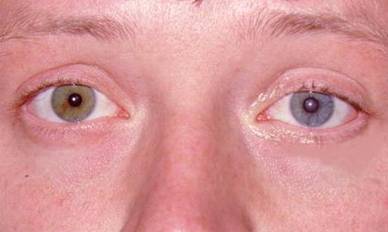Ptosis with Acquired Horners
Horner's syndrome or Horner syndrome is a clinical syndrome caused by damage to the sympathetic nervous system. It is also known by the names Bernard-Horner syndrome or Claude Bernard-Horner syndrome or as oculosympathetic palsy.
- Signs found in all patients on affected side of face include ptosis (drooping upper eyelid from loss of sympathetic innervation to the Müller or superior tarsal muscle, upside-down ptosis (slight elevation of the lower lid), and miosis (constricted pupil) and dilation lag.
- Enophthalmos (the impression that the eye is sunk in) and anhydrosis (decreased sweating) on the affected side of the face, loss of ciliospinal reflex and blood shot conjunctiva might possibly occur depending on the site of lesion.
- Also flushing of the face is common on the affected side of the face due to dilation of blood vessels under the skin.
In children Horner syndrome frequently leads to a difference in eye color between the two eyes (heterochromia). This happens because a lack of sympathetic stimulation in childhood interferes with melanin pigmentation of the melanocytes in the superficial stroma of the iris.

Pathophysiology
Horner syndrome is due to a deficiency of sympathetic activity. The site of lesion to the sympathetic outflow is on the ipsilateral side of the symptoms. The following are examples of conditions that cause the clinical appearance of Horner's syndrome:
- First-order neuron disorder: Central lesions that involve the hypothalamospinal pathway (e.g. transection of the cervical spinal cord).
- Second-order neuron disorder: Preganglionic lesions (e.g. compression of the sympathetic chain by a lung tumor).
- Third-order neuron disorder: Postganglionic lesions at the level of the internal carotid artery (e.g. a tumor in the cavernous sinus).
If someone has impaired sweating above the waist affecting only one side of the body, yet they do not have a clinically apparent Horner's syndrome, then the lesion is just below the stellate ganglion in the sympathetic chain.
Neurologic conditions associated with Ptosis
- Horner's syndrome
- Heterchromia (iris)
- Anophthalmos
- Blepharoplasty
- Blepharospasm
- Brow Lift
- Congenital
- Dry Eye
- Eyelid Laxity
- Face
- Infections
- Inflammation
- Lacrimal System
- Lagophthalmos
- Latisse
- Locate an MD
- Orbital Tumors
- Ptosis
- Skin Rejuvenation
- Skin Tumors
- Symblepharon
- Thyroid Eye Disease
- Trauma

